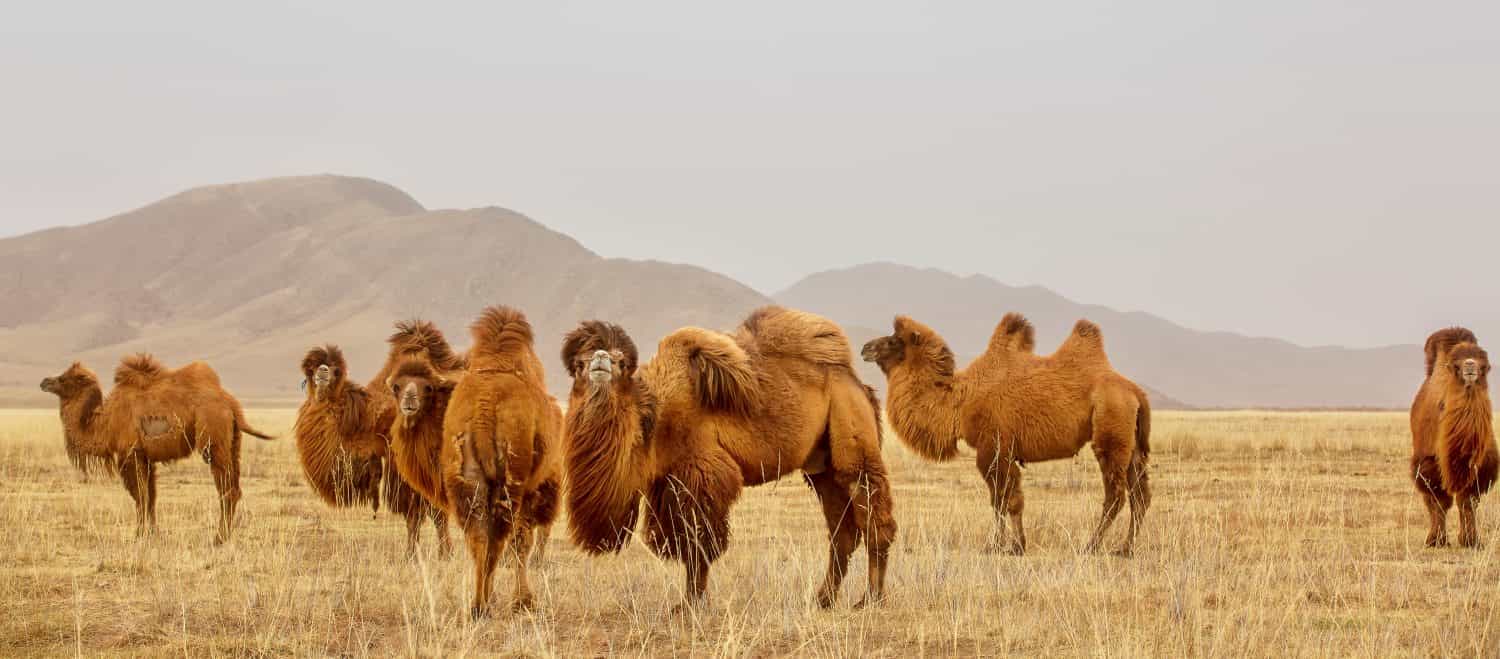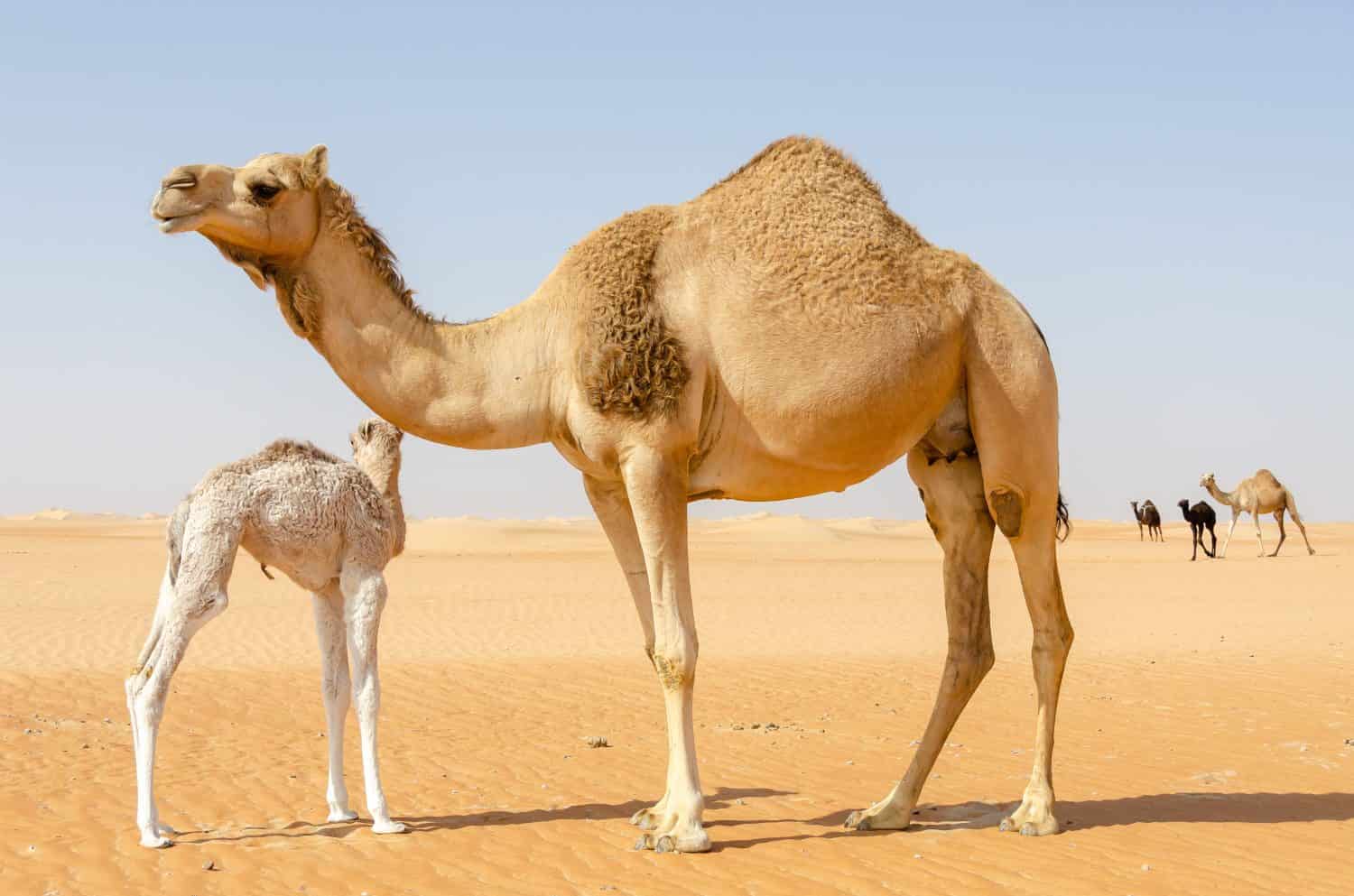Today, most people recognize the unmistakable silhouette of a humped camel. The vast majority of the world’s camels are “dromedary camels,” or what are more commonly known as “Arabian camels.” Arabian camels are domesticated, and have been used by humans for thousands of years. Throughout history, camels have often been used for travel, particularly in desert climates. They are uniquely equipped to survive in a desert environment thanks to their ability to last for lengthy periods of time without having food or water.
However, in addition to being a source of transportation, camels also provide people with milk and meat. Their hair can also provide fiber and felt for making textiles. These qualities make the camel an extremely useful animal! This mammal is certainly a unique creature. Yet as recognizable as an Arabian camel is, many people may not know how to distinguish between a male and a female camel or know the major differences between them. If that’s you, don’t worry – this article will cover several of the key differences between male and female camels. Let’s go!
Comparing Male and Female Camels
| Quality | Male Camel | Female Camel |
|---|---|---|
| Size | 900-1,400 pounds | 600-1,200 pounds |
| Physical Traits | Light brown or gray hair, humps, thick eyelashes, and large nostrils | Light brown or gray hair, humps, thick eyelashes, and large nostrils |
| Reproduction | Sexual maturity at age 6 | Sexual maturity at age 3-4 |
| Uses | Meat, hair (for textiles), transportation | Milk, meat, hair (for textiles), transportation |
Key Differences

Camels are one of the most recognizable desert mammals thanks to their iconic humps.
©BearFotos/Shutterstock.com
When it comes to the key differences between camels, the males and females have a lot more in common than you might expect. Some of the key differences between them include:
- Male camels are called “bulls” and female camels are called “cows.”
- Male camels are bigger than female camels and can weigh several hundred pounds more.
- Male camels reach sexual maturity at age 6, while females reach sexual maturity at age 3-4.
- Male camels often have a more dominant temperament.
- Female camels can be a source of milk, meat, transportation, and hair. Males can provide all of the same resources except for milk.
Male vs. Female Camels: Size

The appearance of a camel will depend largely on its species, not its gender.
©Alex Tumee/Shutterstock.com
Male camels typically weigh between 900 and 1,400 pounds. In comparison, female camels typically weigh about 10-20% less – closer to 600 to 1,200 pounds. These sizable creatures regularly grow to 6 feet tall at the shoulder level and attain a length of about 10 feet across. However, the average male camel will be taller than the average female camel by a few inches.
Male vs. Female Camels: Physical Traits

Camels can live for decades.
©Yasser El Dershaby/Shutterstock.com
Camels tend to be light brown in color, with thick eyelashes that protect the camel’s eyes from the blowing desert sand, and nostrils that can also close to keep out sand and dust. Contrary to popular belief, both male and female camels develop humps. However, the difference between camels with one hump vs. two is not the gender, but the species. Dromedary (or Arabian) camels have one hump. Bactrian camels have two humps. You can learn more about the differences between these two species here! When it comes to differences in their physical traits, female camels and male camels are mainly differentiated from each other by size and their different reproductive organs.
Male vs. Female Camels: Lifespan and Reproduction

Baby camels, which are called calves, may nurse for up to 18 months after their birth.
©Lotta Axing/Shutterstock.com
Female camels typically reach sexual maturity around their third birthday and will mate by age 4 or 5. In comparison, though male camels start to rut at age 3, they do not achieve full sexual maturity until around age 6.
Female camels can give birth to a newborn (or, on rare occasions, two newborns) after a gestational period of 12 to 14 months. During this period, a female camel will isolate herself from her herd in preparation to give birth and find a vegetative environment where her baby can be born. A newborn camel will not yet have humps, but will be able to walk within 30 minutes of its birth. The newborn baby camel, called a calf, and its mother will stay separate from the herd for a few weeks before rejoining the group. The calf will nurse for up to 18 months after its birth and will eventually reach its full adult size around age 7. Female camels typically only give birth to one baby.
Both genders of camel can live to be 40 to 50 years old in captivity, and about 40 years old in the wild.
Male vs. Female Camels: Temperaments

Male camels tend to direct the herd from the back, while female camels take turns leading.
©Occipitalis Creations/Shutterstock.com
People who own camels often describe one of the biggest differences between male and female camels as a matter of temperament. Male camels tend to be more dominant within herds or family groups and will lead the family from behind. In comparison, female camels take turns leading.
Male vs. Female Camels: Uses

Camels have long been a source of transportation to bring people through the arid desert climate.
©Nisangha/iStock via Getty Images
While humans can ride both male and female camels and use them for transportation, when it comes to their other uses, only female camels produce milk. Female camels only produce milk after they successfully mate and have a calf born alive.
However, both genders can be eaten. Often, people will choose to slaughter male calves that are considered not suitable for breeding. Older camels, including male bulls and female cows that do not bear calves, can both be a source of meat.
The photo featured at the top of this post is © iStock.com/Chalabala
Thank you for reading! Have some feedback for us? Contact the AZ Animals editorial team.







